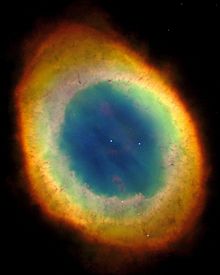
Back سديم إشعاعي Arabic Эмісійная туманнасць BE Емисионна мъглявина Bulgarian Emisijska maglina BS Nebulosa d'emissió Catalan Nibulosa à emissioni CO Emisní mlhovina Czech Emissionsnebel German Νεφέλωμα εκπομπής Greek Emisia nebulozo EO

An emission nebula is a nebula formed of ionized gases that emit light of various wavelengths. The most common source of ionization is high-energy ultraviolet photons emitted from a nearby hot star. Among the several different types of emission nebulae are H II regions, in which star formation is taking place and young, massive stars are the source of the ionizing photons; and planetary nebulae, in which a dying star has thrown off its outer layers, with the exposed hot core then ionizing them.[1][2]
- ^ "Nebulae." (October 2014) World of Physics, Gale In Context: Science, Doc no. CV2434500333, Retrieved May 27, 2023.
- ^ Belleville, Michelle (Jan 13, 2023). "Emission Nebulae". Hubble's Nebulae. NASA. Retrieved May 27, 2023.